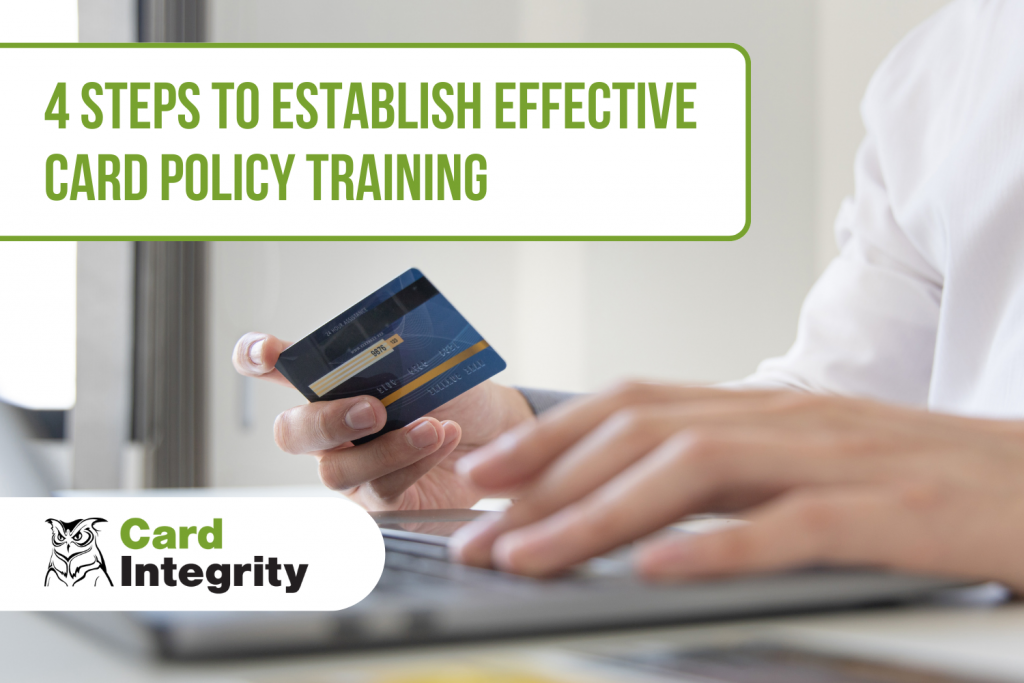In order to maintain and grow your card program, changes are often required. As your goals and card policy change, it’s important to make sure employees are up-to-date with all the new developments.
Fraud, card misuse, and abuse can occur in any organization. One of the best lines of defense against this is thorough card policy training also known as cardholder training.
In this article, we’ll be sharing three key factors that might motivate you to spring clean your card policy along with four practical ways to improve cardholder training efforts to make them more effective.
Table of Contents
When Was the Last Time Employees Received Training?
Running a card program and keeping up with expense audits is a lot of work. From working with vendors and securing contracts to setting guidelines for approved and non-approved purchases, one commonly overlooked area is cardholder training.
Maybe employees are trained initially when they receive their P-Card, Travel Card, or Fleet Card. Then what happens next? Is there a way to keep up with the last time each person received training?
Or, are there annual training opportunities that get met consistently?
If it’s been a while since employees were invited to training or required to go over the card policy, you could be leaving the door open for card misuse and fraud to occur.
It’s much easier for an employee to say “I didn’t know” when they fail to use a preferred supplier. This sentiment can also be used if an employee happens to book an additional (unapproved) night at a hotel with their Travel Card or makes a questionable gift card purchase.
Being oblivious to the rules or worse, bending them to your advantage, doesn’t have to be the norm when consistent and frequent training is offered.
Card Policy Details Have Likely Changed
So much has happened in the past few years. Perhaps, your organization has seen significant changes within the last few months alone. Another reason to keep an up-to-date policy followed by regular training is that it can be extremely relevant to your goals.
Have approved suppliers changed? What about amounts and spend categories? Did you update your receipt submission procedure? Will there be more or less business travel this year?
These are all areas to explore as you update your card policy. Keep in mind that sending a simple email with the update to employees is not enough. People get busy during the work day and may not even read an isolated email thoroughly.
Or, they could simply forget about the small note they read and not adopt the new card policy detail.
Staff Shortages Can Impact Effective Training Efforts
Many organizations have been experiencing a lot of staffing shortages this past year. Many lost their jobs during the pandemic while some retired and others simply moved on to new opportunities.
If you are in maintenance mode right now, you’re not alone. There’s nothing wrong with trying to keep things afloat and prioritize tasks. However, falling too behind on cardholder training can lead to many unwanted issues.
When there’s an outdated card policy and no encouragement or options for training, some people may view this as an opportunity to test the waters.
Maybe it starts with a small unauthorized purchase to see if it gets noticed. Then, things advance to where there are larger purchases being made or even payments to a personal account.
One county official was recently caught using their P-Card to send more than $400 to a personal PayPal account. The employee claimed the transfer was an honest mistake as they mistook their P-Card for a personal card. However, an investigation was still opened.
If your card policy and training program clearly state the consequences for P-Card misuse and fraud, this will naturally deter employees from testing the waters in this way. It should also reduce honest mistakes and help cardholders be more mindful of how they’re handling their cards.
The good news is that you can still provide effective training with a lower staff number. Below we’ll discuss a few proven ways to level up your cardholder training efforts whether your team is large or small.
Better Ideas to Streamline Card Policy Training
Whether your policy has changed significantly or roles have been shifted to adapt to a worker shortage, there are still a few key things you can do to properly train employees holding a P-Card.
These four steps can be used to ensure that cardholders are well aware of your policy and best practices.
Step 1: Move Training Online
If you haven’t already, consider transitioning to hosting an online cardholder training program. In-person training has a time and a place. However, it can be a hassle to round up every employee and accommodate each person’s availability.
Plus, you’ll be tasked with reserving the space (preferably a large enough conference room) to host the training. Add in the challenge of having less staff and organizing a training session will easily become more of a hassle.
Instead, invite employees to complete an online training course. Include all the policy information they need and make it easy to digest either in one sitting or within attainable steps.
Step 2: Make It Thorough and Fun
Cardholder training doesn’t have to be boring and technical. Get creative and include lots of examples and details to keep employees engaged. Think about what you’d like to see if you had to take the training with a fresh set of eyes.
What would keep your attention? Is there someone on the team who can add some graphics or visuals to the training?
You can also include a short quiz after each section and offer a certificate to whoever answers a majority of the quiz questions right.
Brainstorm training engagement ideas with other team members and management to develop the right solutions for your organization.
Step 3: Track Progress and Prioritize Retention of Information
This is an important aspect of your new and improved card policy training system. Start tracking when each employee has successfully completed the training so you’ll know where they stand.
It’s also a good idea to provide refresher training for existing employees to remind them of the card policy.
While training is a key tool, the ultimate goal is to make sure employees retain the information they learn. Providing quizzes through an online training platform can be way more effective than simply asking the employee to sign a document confirming they completed the training.
Step 4: Consider Outsourcing Cardholder Training
Card policy training shouldn’t be skipped over for an extended period of time. Still, it can be a time-consuming and labor-intensive task.
This is why you may want to consider outsourcing cardholder training to a third-party company like Card Integrity.
That way, all you’ll need to do is provide your card policy and preferences. Then, you’ll get a custom and interactive online training course that employees can have on-demand access to.
Depending on your needs, outsourcing training may be worth it in order to buy back time in your work day to focus on other important tasks.
As a result, you won’t be stretched as thin and employees can still receive effective training materials.
Protect Your Card Program with Training That Works
Don’t overlook card policy training. Thorough training will help employees be accountable for their card spend and weed out card misuse due to a lack of understanding.
Coming up with an interactive cardholder training program that helps employees retain the information they learn doesn’t have to be a challenge.
Explore Card Integrity’s TrainingWISE, a service that allows our team to create a comprehensive cardholder training course for your employees that’s built around your unique policy details.
We will create a course outline, engaging lessons, quizzes, and progress tracking so you’ll have everything you need.
Learn more about our TrainingWISE service and ask for a demo to see how it works.
Having everyone on the same page in terms of training and best P-Card practices will further support card program goals.
Find More Articles on Training
-
Cardholder Training Despite Time, Budget & Resource Constraints

Cardholder training is one of many internal controls that organizations can use to bolster their protection against fraud, misuse, and abuse on company issued credit cards like P-Cards and travel cards. What sets it apart from other internal controls is that cardholder training is designed to stop fraud and misuse before they ever happen. Other
-
Seven Training Tips to Ensure Employees Understand Corporate Credit Card Policy

Commercial credit cards are an amazing time saver. Corporate travel cards and p-cards provide organizations and employees with an easier and more convenient way of handling business travel, making business purchases, and tracking business expenses. To maintain these wonderful benefits, card programs can’t just issue the cards and forget about them. Card managers need to
-
Reinvent Your Organization’s Travel Card Program

Learn about vulnerabilities that may exist in your travel card program and the importance of monitoring expenses for potential fraud.



